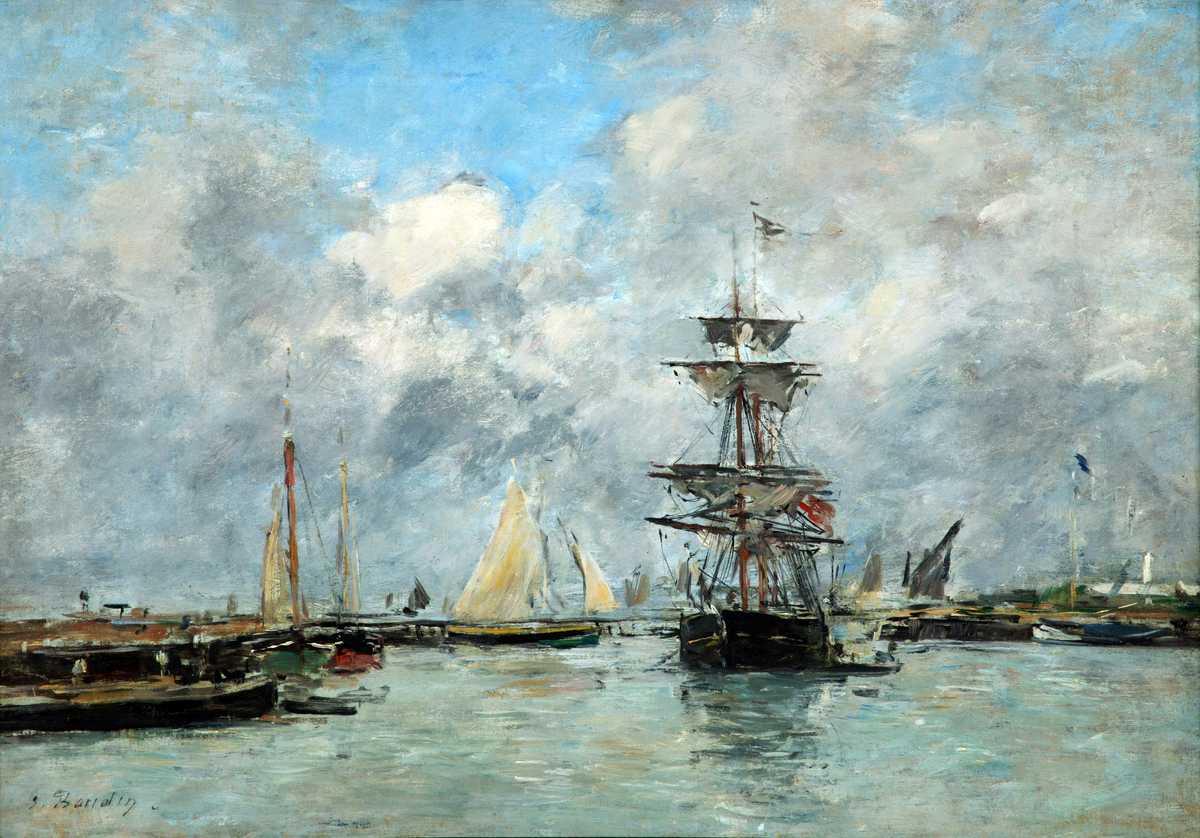Trouville Harbour
Eugene-Louis Boudin 1824 - 1898
Summary
Seawater ripples beneath a radiant, clouded and textured sky in this view of the harbour at Trouville in Normandy. Boats are tied up at scarcely indicated jetties to the left and right, while a large, three-masted sailing ship lies at anchor in their midst. This bright, airy, loosely brushed painting is a typical example of Boudin's work. Born in Honfleur, the son of a ship's captain, Boudin spent much of his career painting on the coast of Normandy, capturing the changing effects of light on water. His experimental treatment of light and atmosphere was influential for the development of Impressionism, but he drew inspiration from it too. He used a more subdued palette than many of the young Impressionists, however, which ensured that his work was more readily acceptable, particularly to audiences in Britain. Boudin exhibited regularly at the Salon from 1863 to 1897, and at the First Impressionist Exhibition of 1874.
Display Label
Channel Crossings English and French Impressionism and Post-Impressionism from the collection of Manchester Art Gallery This display looks at the allure and excitement of French art for a generation of English and Scottish painters emerging from the claustrophobia of late Victorian painting. Breaking with the Classical rigours of the Academy and the Salon, the artists who came to be known as the Impressionists painted naturalistic scenes with loose and quickly applied brushwork to convey the effects of light and the natural colours of shadows which had previously been rendered with blacks and browns. They explored the French countryside where they learned how to paint directly en plein air closely studying the changing effects of the seasons. Making regular visits to or studying in Paris, English and Scottish artists were in turn enthralled by these painterly discoveries. The new method of painting they then applied to the English landscape, to still lifes, portraits and interiors. Painters of the New English Art Club like George Clausen, John Singer Sargent and Philip Wilson Steer combined the subject matter of late Victorian genre scenes with the new style. Works by these artists and others are here shown alongside a few choice examples of French Impressionism from the collection and by the fore-runners of Impressionism; Eugène-Louis Boudin, Charles Daubigny and Johan Jongkind. While the English artists went to France the French painters and their dealers, such as Paul Durand-Ruel, escaped the Franco-Prussian war of 1870-71 and went to London. Their paintings were seen in England and some were even bought by Manchester collectors. In the Edwardian era newer developments in French art inspired English and Scottish artists on their cross-Channel trips and via a series of influential London exhibitions. The high-keyed colour and bold lines of the Post-Impressionist paintings of Paul Gauguin and Vincent Van Gogh were now huge influences on the artists of the Camden Town Group such as Harold Gilman and Charles Ginner. Later still Matthew Smith was to take his inspiration directly from Henri Matisse under whom he studied in Paris.
Object Name
Trouville Harbour
Creators Name
Date Created
1880-1885
Dimensions
canvas: 38.4cm x 54.5cm
frame: 62.4cm x 79.5cm
accession number
1947.71
Place of creation
France
Support
canvas
Medium
oil paint
Credit
George Beatson Blair bequest, 1941.
Legal
© Manchester Art Gallery

